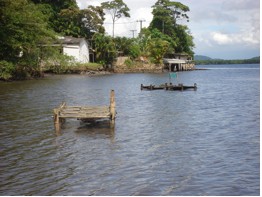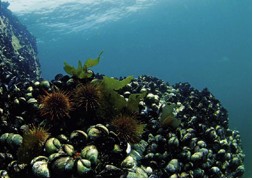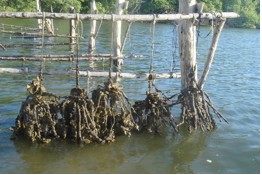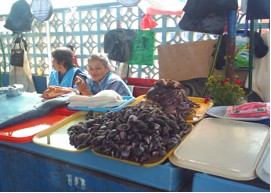|
|
|
Shellfish Restoration
Network
|
Distributed by The Nature Conservancy's Global Marine Initiative
|
Towards a South American Network for Shellfish Conservation and Restoration Since 2007, a team of scientists assembled by The Nature Conservancy, with funding support from The Kabcenell Foundation, has been developing a global-scale assessment of native bivalves that form reefs and beds: Global Shellfish Reefs at Risk. In South America, we exchanged information with a number of active researchers working on oyster and mussel ecology and management, and received invaluable input to our analysis via expert surveys (translated into Spanish). Along with an extensive literature search, we were able to generate rough estimates on some shellfish populations within estuaries and overall condition at an ecoregion scale. To date, we are unaware of any studies that more directly measure the extent or rate of decline for South American shellfish populations. This may be due to a lack of interest in these systems, but is probably also limited by the amount of economic support this kind of research receives in South American countries. Given the results of our initial surveys and literature reviews, we felt that there was an urgent need to raise awareness on shellfish issues on the continent and to focus our scientific colleagues on some of the most pressing data gaps. The collection of scientific data that describes the condition (degradation) of shellfish populations will surely have cascading effects, raising interest and promoting more conservation and restoration programs. Thus, we felt that early involvement of local scientists and managers as a next step in the Shellfish Reefs at Risk Project was a prerequisite to the development of continental-scale conservation network directed to improve shellfish condition in South America. To this end, we convened a workshop during the VII Latin-American Malacological Congress (Valdivia, Chile, November 8-9; http://www.clama.cl), inviting experts from Colombia, Venezuela, Brazil, Uruguay, Argentina, Chile and Perú. Participants were asked to: 1) present updates on the current situation of oyster and mussel conservation in their countries; 2) identify case studies focused on conservation action, including shellfish restoration projects; and 3) help to write a brief national report summarizing shellfish condition information from different locations, using a common reporting structure. Since most of the workshop participants are directly involved with shellfish stock assessment and management or are engaged in current conservation or restoration programs in their nations, they provided invaluable insights on these topics. The most troubling finding from the workshop was that nearly half of the assessed shellfish populations were either moderately or highly threatened by over fishing and environmental degradation. We are now preparing workshop proceedings for publication in an appropriate scientific journal. Another primary outcome from the workshop was the creation of a participative South American Network on Shellfish Conservation and Restoration, involving scientists from around the continent. This network will serve to bolster conservation and/or restoration initiatives, link research teams and provide a framework to pursue additional financial support for new and/or ongoing conservation initiatives that benefit South American shellfish populations. |
|
Meeting
Participants and Affiliations Omar Defeo, Dirección Nacional de Recursos
Acuáticos, Uruguay; Unidad de Ciencias Adriana Gracia, Instituto de Investigaciones
Marinas y Costeras, Colombia; Alex Gamarra, Instituto del Mar del Perú; agamarra@imarpe.gob.pe Marcela Pascual, Instituto Alte. Storni,
Argentina; criadero@canaldig.com.ar Marcelo Henriques, Instituto de Pesca, Sao Paulo, Brasil; henriquesmb@pesca.sp.gov.br Luis Prado, Pontificia Universidad Católica de Chile; lprado@bio.puc.cl Luis Leon, Universidad del Oriente, Venezuela; lbleon@cantv.net César Lodeiros, Universidad del Oriente, Venezuela; cesarlodeirosseijo@yahoo.es
Country
Summaries Restoration efforts are now focused on two species: the mussel Mytilus platensis and the flat oyster, Ostrea puelchana, both in North Patagonian Gulfs. M. platensis has been exploited by industrial dredging (1983-1992), artisanal dredging (2002-2007), and diving (2001-2008). The mussel populations declined in all the gulf grounds, reaching very low densities and poor recruitment. Dredging and absence of fishing regulations are identified as possible causes of population decline. A project is about to begin to restore the population of El Sótano, a traditional mussel bed located in an area characterized by strong recruitment. The San Matías Gulf offered the rare opportunity of studying the structure of one of the few natural and untouched flat oyster populations in the world, the puelche oyster. The information gathered from extensive surveys performed in 1985 support a fishing closure in 1980. Unfortunately, the cultured stocks suffered heavy mortality in 1996, likely from a combination of clandestine small-scale fishing and other anthropogenic factors. This species is particularly vulnerable to exploitation because of its common cluster habit and also its peculiar reproductive biology with carriage of dwarf males, a feature that makes it a unique case among bivalves. Restoration and conservation efforts are being developed to: 1) evaluate the condition of the three main grounds and compare them with prior surveys; 2) determine the age structure oyster populations; 3) assess biomass and demography of San José populations; and 4) initiate seeding experiments to evaluate hatchery seed for restoring the most severely depleted beds. Brazil There are a number of ongoing initiatives linking poverty alleviation with sustainable extractive activities in Pernambuco, Rio Grande do Norte, Paraíba, Bahia, Sao Paulo and Santa Catarina states. To this end, US$ 3,127 is being invested in Pernambuco, Rio Grande do Norte and Paraiba. The Brazilian model of co-management for natural resources known as “reservas extrativistas” (RESEX), developed with fishers, government agencies and partners in Sao Paulo and Santa Catarina are considered a promising tool to conserve native shellfish populations in the country. http://www.ibama.gov.br/
Chile All the exploited species present several conservation problems. A. atra is heavily affected by environmental phenomena, particularly El Niño events which contribute to decreases in the population. The recent introduction of Mytilus galloprovincialis has yet to be fully evaluated as a threat for native mussels in the Chilean coast, but in the future this species could represent a serious threat as dominant competitor, displacing native species of mussels. Several management policies have been adopted to help ensure long-term sustainability of native habitat-forming bivalves. First, all exploited species have minimum legal size limits for extraction. Second, the Fishery Subsecretary has created two genetic reserves aiming to protect the stocks of C. chorus and O. chilensis. The implementation of Coastal Marine Protected Areas (CMPA) opened new avenues for conservation of bivalves in Chile, and the recovery of natural banks of Choromytilus chorus in Lafken CMPA has been reported. Third, re-seeding is being attempted with A. atra and C. chorus, but there are no reported results for these experiences. For Choromytilus chorus, it has been shown that the area must be large enough to ensure the presence of several patches with asynchronic recruitment and the presence of certain species of algae to promote successful recruitment.
On the Caribbean coast, mangrove oysters Crassostrea rhizophorae, have been important for fisheries production but have been affected by alterations in river flow. The population in the largest coastal lagoon Cienaga Grande de Santa Marta (CGSM) had nearly vanished by 1996, although recent monitoring data suggests that a remnant population exists. Full recovery of this population is hindered by unauthorized harvest and although C. rhizophorae is included on Colombia’s Red List of threatened species there are no near-term management plans for conservation. Ideally, future management plans should include restoration of oyster beds combined with development of aquaculture to reduce pressure on remaining wild stocks.
Peru Warm El Niňo events can both positively (e.g., the
scallop Argopecten purpuratus) or negatively (e.g., the mussel
Aulacomya atra) affect shallow subtidal bivalve populations. Both
species are heavily exploited, particularly A. atra. In the
transition zone located between 3°24’ and 6° S, the oyster Ostrea
iridescens and the mangrove clam Anadara Conservation efforts directed to commercially
important bivalves are recent, and mainly Priority actions for the conservation of peruvian
shellfish include: (1) increasing stakeholder involvement in the
management of sustainable populations of shellfish
(2) Related links: www.imarpe.gob.pe
Uruguay The condition of native mussel beds, overall, is thought to be fair. Despite the lack of quantitative information, and with the exception of the commercially exploited beds of M. edulis, there is no evidence supporting significant declines of mussel beds in Uruguay. However, there are severe gaps in the biological knowledge needed for the sustainable management of wild fisheries, and critical deficiencies in monitoring and management capabilities. The main recommendations for sustainable use and long-term conservation of Uruguayan mussel beds are 1) adoption of an ecosystem level approach for fisheries management; 2) implementation of conservation measures directed to preserve "pristine" beds; and 3) development of experimental co-management practices, in particular for small-scale benthic shellfisheries, to link economic issues for artisanal fishermen and conservation. Related links: www.dinara.gub.uy
Venezuela The brown mussel Perna perna and the exotic green mussel Perna viridis are commercially exploited. Some research suggests that P. viridis is displacing P. perna. Mussel extraction is also declining, from 360 to 200-250 tons since 2000. There are some government initiatives promoting aquaculture, and some coastal communities are involved in small scale production. In order to improve the conservation status of oyster beds in Venezuela, there are proposals to restore beds in the Mochima National Park, using a community-based approach. Additionally, it will be necessary to improve conservation measures for beds in good shape (e.g. La Restinga lagoon, Margarita Island). The native brown mussel P. perna is in urgent need of conservation attention with a focus on improving fishery management approaches to restore the depleted beds.
| |
|
|
 |











